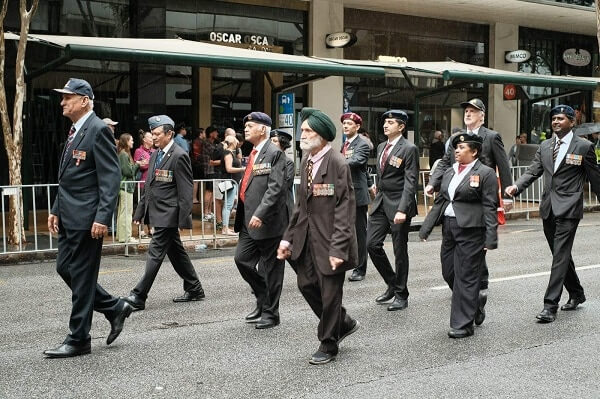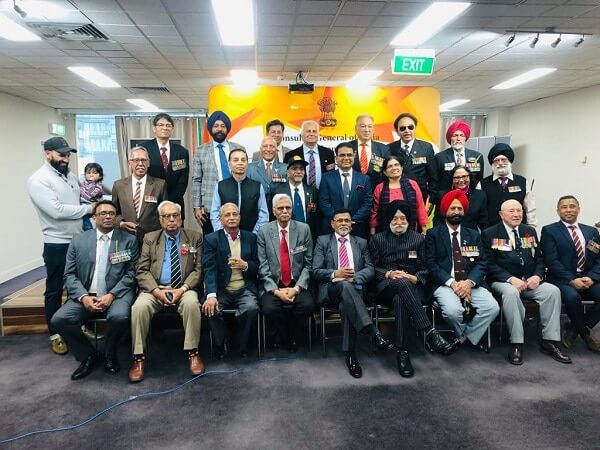When Col Avtar Gill marched in the Anzac Day Parade in Brisbane this year, he paid a special tribute to his forebears at Gallipoli.
The 14th Sikh Regiment is mentioned with much reverence in discussions on the Indian links of the ANZAC campaign at Gallipoli in 1915. For Col Gill, that regiment has much emotional significance.
“It’s my regiment,” he told Indian Link.
Well, not exactly, the former Indian Army officer elaborated. “I am from the Sikh Regiment myself, yes. And the 14th Sikh (Ferozepur) Regiment has been the most decorated batallion of the Indian Army in history. After Independence, it was redesignated as the 1st Sikh Regiment, and the decision taken that in honour of its men, the number 14 in Sikh Regiments will never be raised again. That is the level of regard with which we look upon the men of the 14th Regiment.”
The 14th Sikhs suffered the highest casualties in Gallipoli, returning home with only four of its 383 men.
“We march each year to honour all soldiers who have fallen in the line of duty, but particularly those that were in Gallipoli,” Col Gill told Indian Link.

He marched this year with 13 other former Indian defense personnel – including one woman officer. Brisbane’s Anzac Day Parade has had an Indian contingent since 2017, and Col Gill has been participating since.

Leading the Sydney parade this year was Charanpreet Anand, who has just left the Australian Defence Force after 15 years.
At the head of 24-strong contingent, he marched in civilian clothes for the first time. But the sentiments were the same as in previous years. His own links to World War I are more direct – his great grandfather fought in the war.

It’s a fact he learned not so long ago.
“I’ve been posting a particular photo of Sikh soldiers as my Anzac tribute for years now,” he told Indian Link. “Imagine my surprise when I showed it to my grandmother one time, and she said, that’s my father.”
Charanpreet knows now that the soldier being offered a rose in the image is his great grandfather Havildar Nanak Singh of the Indian Army’s 107 Pioneers Regiment.

“When we march we remember men like him, and all those soldiers who came before us. We remember what they did – and what we did – for our country.”
In his own service, Charanpreet has been able to make a mark.
“I was the first turbaned Sikh to be to be commissioned as Leading seaman,” he revealed. “I saw a lot of sea time, in fact 12 of my 15 years were spent on ships. Equally gratifying was my work in recruiting. Given my own background I was able to educate people about diversity. There wasn’t much awareness before then.”

In Melbourne, Col Rajesh Kaswan organised this year’s Indian contingent. It included some 30 participants, men and women, many of them former officers of the Indian forces, some veterans visiting from India, and some surviving family members. Four first-time marchers joined in this time.
“Participants wore their medals and Regimental caps, and marched as ‘Commonwealth Veterans’. All Allied Forces and those who are Commonwealth countries, are clubbed together as such – though we all march under our respective countries’ flags,” he described.

He added, “This is an occasion for us veterans to showcase the spirit of camaraderie and paying our homage to the fallen soldiers, not only in the battle of Gallipoli but even in battles earlier and later.”
He himself was commissioned in 6 Sikh Light Infantry in 1990, later commanding the 1st Sikh Light Infantry.

The annual lunch for veterans, hosted by the Consul General of India (Melbourne) after the parade, was on again this year.

In Perth, Cdr Rajesh Mittal joined the Indian Veterans contingent at this year’s Anzac Day parade.
“We were keenly looking forward to the parade, the last two years being a damp squib due to COVID,” he revealed.

“It felt wonderful even though we had a low turnout this year of 16 members only. It’s great to see how the Anzac tradition has evolved. It started off as a memorial to Gallipoli but now it is a tribute to all combat deployments since then. Every village, town, even suburb, has a memorial to its military sons. It’s very heartening also to see youngsters undertake a pilgrimage to Gallipoli to pay respects to their family members who lost their lives there.”
Col Avtar Gill lamented that India’s own military history in the World Wars is not well recorded. “There has been much interest in defense circles, as this history is unearthed, but the civilian population is still quite unaware. That’s why movies like Kesri are appreciated – the story of 21 brave soldiers who stood up to a force of 10,000 in Saragarhi, is now common knowledge.”
Do these veterans think that India should also honour its military sons in similar fashion?
Col Rajesh Kaswan was cautious in his reply.
“This is a contentious issue. In any case, we have our own Martyr’s Day, Vijay Diwas, Kargil Diwas, etc.”
Cdr Rajesh Mittal was more accepting.
“I think such an event is long overdue,” he stated. “Perhaps even the Military has not done enough. Much more needs to be done to recognise and remember our soldiers who have laid down their lives for the country. Australia has not let the memories of its soldiers die out. In fact, it has taken pains to keep them alive. The Australian example should be emulated.”
There’s one thing, though, about which these former Indian officers are equally passionate – the memories of their service, especially when they saw action as protectors of the nation.
Col Gill smiled as he recounted his time in the line of duty.
“I served in Siachen in 1999-2001, flying helicopters into the glacier. When I arrived there, one of the first things I was told, was that there are 21 of our helicopters lying beneath the glacier. That was the extent of our casualties then, but that’s the kind of challenge the Army had prepared me for.”
Clearly, the spirit of the 14th Sikhs who lie at Anzac Cove today, continues to live on in the 1st Sikhs.




